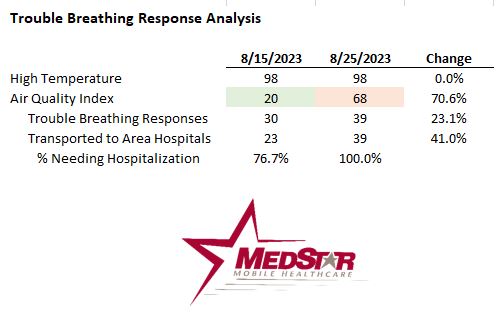MedStar’s response volumes for respiratory conditions generally increase on Air Quality Alert days, sometimes as high as 23% higher!
Here’s a comparison grid for 2 days in the last 10. August 15th, 2023, with an Air Quality Index of 20 (good), compared to August 25th, 2023, with an air quality index of 68 (bad).
We picked these 2 days for comparison because the temperature was the same, so this change would unlikely be due to temperature deviations.
According to the American Lung Association, four groups of people are especially vulnerable to the effects of breathing ozone:
- Children and teens
- Anyone 65 and older
- People with existing lung diseases, such as asthma and chronic obstructive pulmonary disease (also known as COPD, which includes emphysema and chronic bronchitis); and
- People who work or exercise outdoors.
During Air Quality Alert Days, it’s a good idea to try and stay indoors, preferably in an air-conditioned environment, especially if you have any of the conditions listed above.
Don’t ignore warning signs, if you are outdoors and experience symptoms of difficulty breathing, go indoors in an air-conditioned environment. If the symptoms don’t subside, seek immediate medical attention.







